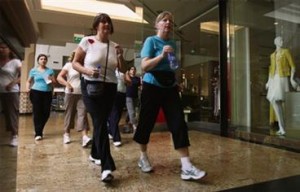By Aimee Greaves www.business24-7.ae
Ten thousand steps might seem like a long way, but that’s the magic number you need to walk every day to stay healthy, according to new research.
 A study carried out by master developer Limitless has found people in Dubai only take an average of 5,000 steps. That’s half the recommended distance.
A study carried out by master developer Limitless has found people in Dubai only take an average of 5,000 steps. That’s half the recommended distance.
The alarming results, tabulated in March, were released this week. The firm, which is building the $12 billion (Dh44bn) Downtown Jebel Ali, questioned more than 600 people about their walking habits and gave pedometers to 188 people to track their steps over seven days.
Although local residents are not as active as they should be, Dr Andrew Devine, Specialist in Family Medicine at The City Hospital believes the majority do even less than those who took part in the study.
“I don’t think many people will be anywhere near 5,000 steps. I wear a pedometer every day at the hospital and do about 2,000 or 2,500 steps tops but because I need to do 10,000, I have to go to the gym or go walking. I don’t think it’s possible for the average person to do 5,000 steps in Dubai,” he says.
But while it may seem like a steep feat to do 10,000 steps, it doesn’t mean pounding the treadmill every day; simple activities such as walking to work, to the bus stop, the shops or even taking the stairs instead of the lift could do the trick.
Limitless also says its research will help it better plan its communities, which already focuses on pedestrians.
But CEO Saeed Ahmed Saeed says it goes beyond health. “We want to promote awareness of the importance of walking for wellbeing. Inactivity can cost economies billions of dollars by placing enormous strain on health services. It can also lead to lost working days because inactive people are more likely to fall ill. Walkable communities with carefully planned infrastructure contribute to a more sustainable society by boosting the economy, improving social lives and reducing harmful emission from cars,” he adds.
Although the summer makes walking in the UAE more difficult, Dr Devine says people can still do more. There is even a mall walking community in the Emirates, where people pace up and down before the stores open.
“Mall walking is very popular in the United States but here you have to get up early to do it, otherwise you’ll have to dodge all the shopping just strolling around,” says Dr Devine.
“But the health benefits of walking are enormous. It not only helps people lose weight, but lowers cholesterol and blood pressure so it should be encouraged.”
Limitless’s research also found that Asian people walk the most, with an average of 6,687 steps a day, while those earning less than Dh15,000 a month walk more than people earning in excess of Dh25,000 per month. Meanwhile, the opening of Dubai Metro next month is predicted to make a difference to walking habits as people choose to leave their cars at home in favour of walking to the station.
“Those who use the Metro will have to walk further but anything that encourages people to leave their car at home is good,” says Dr Devine. “It takes no time to get in your car but people will have to make the effort to get to the Metro and it will take time to change attitudes.”
Our ped tests
Aimee Greaves average steps: 7,960
After wearing the pedometer for three days, I averaged almost 8,000 steps a day but only because I ran or went to the gym every day.
If I hadn’t done the exercise I would have barely scraped 3,000 steps a day, which although worrying, did not surprise me.
I take the lift to my car, before driving to work and because my office is in Al Quoz the furthest I walk is to the canteen.
Outside work I like to think I’m quite active but the pedometer has only highlighted that even 30 minutes on the treadmill every day is not enough to reach 10,000 steps. The most I did was 9,600 one day, which included walking to the supermarket, but even that was not enough. Hopefully, when the weather cools and the Metro opens I’ll cross the elusive 10,000 barrier.
Nic Ridley average steps: 7,753
I was long-aware of the need to walk a recommended 10,000 paces a day – and probably thought even here I wouldn’t be far off this.
However, after wearing a pedometer for three days, I was surprised by the results. Only when I went to the gym – and hit the treadmill – did I reach and breach the target, clocking 11,300 one day.
On the other days, I averaged about 6,000 paces – more than most people, I guess, but considerably short of the target.
A pedometer makes you aware of every step you take – especially when you constantly check the figure and compare it with colleagues. But it also underlines the fact most people do not get the basic exercise they need, and why obesity is becoming a pandemic more dangerous than swine flu.
















